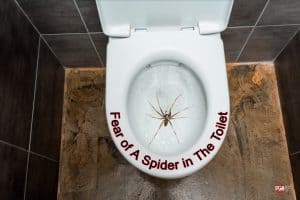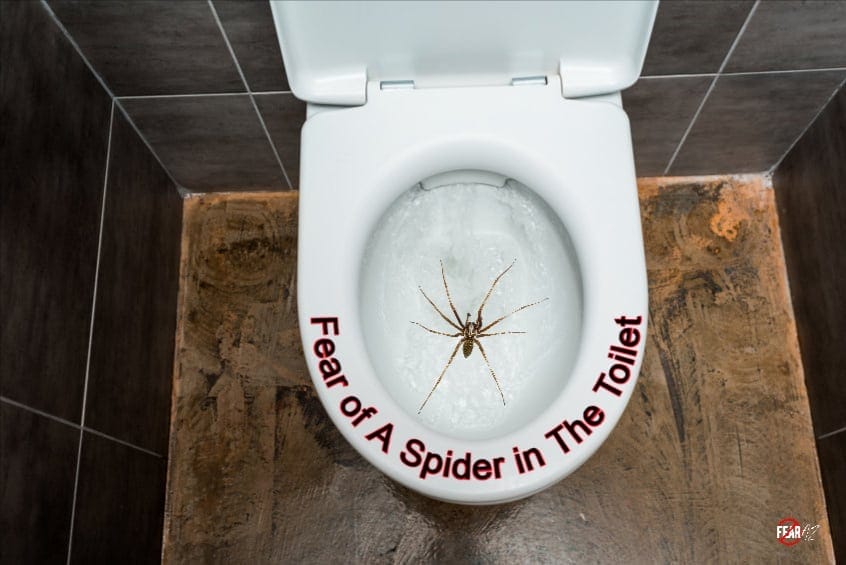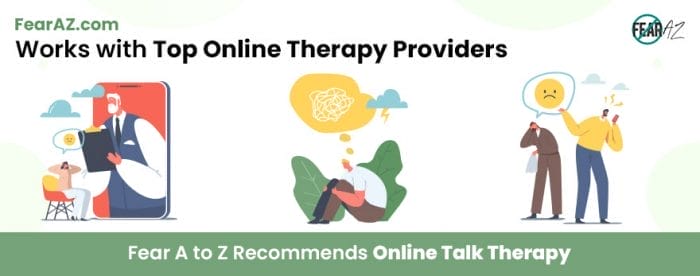Share This Article
Let’s Flush the Fear of Spiders and Snakes in the Toilet
Do you check and recheck under the toilet seat and in the bowl before sitting on the toilet?
Do you have a fear something may bite your derriere while sitting on the household throne?
Have you watched those YouTube videos where people pull a snake from the toilet and now can’t stop thinking about it?
Or the video of a huge spider in the toilet bowl?
Don’t feel embarrassed; you’re not alone. A recent study found that five percent of Americans have a strong, inhibiting fear of spiders and snakes.
If you have a phobia of snakes or spiders in toilets, read on. You may be able to overcome it by focusing on the underlying issue and following some simple steps. First, try to learn when and why you developed the fear. Next, try self-help methods like meditation and relaxation. If that’s not enough, seek professional therapy for intense phobia.

What Exactly Is the Fear of Spiders and Snakes
We’ve all heard stories about snakes slithering through bathroom plumbing and chilling out inside the toilet bowl. Snakes and spiders evoke both disgust and fear in many.
Even a person who hasn’t encountered a snake or spider in their lifetime can develop this phobia. There’s no specific term for snake and spider fear combined. However, the fear of spiders is called arachnophobia, whereas snake fear is known as ophidiophobia.
There has been a debate about whether a snake or spider phobia is innate or learned. Max Planck Institute in Germany conducted a study on infants to answer this specific question. The researchers showed two images to forty-eight six-month-old infants in this study. One had snakes and spiders in it and the other had flowers and fish.
The results were surprising. When the infants saw pictures of snakes and spiders, they reacted with larger pupils. This suggested that the fear could be innate and not learned.
While many people have this fear, some have a specific fear of encountering these creepy crawlers and itsy bitsy spiders in their toilets. There are not many poisonous snakes and spiders in the US, but those who have this fear shiver at the thought of a spider crawling up their arm, no matter how harmless it may be. They may even avoid using a toilet for fear they may see a spider or snake inside.
Causes for Fear of Spiders and Snakes in the Toilet
For millions of years, humans have encountered different poisonous as well as nonpoisonous snakes and spiders. Our ancestors might have been incapacitated or even killed due to bites from these creatures lurking deep within the grass or in trees.
While fewer than eleven people die from spider bites each year, what makes spiders scary is their appearance. The uncertainty that the spider can land on your head or body at any given moment makes it even more frightening.
Snakebites kill up to 138,000 people each year compared to spider bites. So it’s understandable how these two creatures can cause some to fear them enough to hamper their everyday routine.
Everything You Need to Know about the Fear of Spiders and Snakes in the Toilet
Many scientists have concluded that the fear of snakes and spiders has an evolutionary origin. Like primates, we can identify these creepy creatures quickly and react fast because of the reaction mechanism in our brains.
As a result of this apparently inherited stress reaction, we learn to fear or dislike these animals. The combination of this fear with other factors can develop a phobia.
Parents’ fear of these creatures or a genetic predisposition for an overactive amygdala, which is essential to estimate danger, can cause children to be anxious about them.
Having a fear of snakes and spiders inside a toilet is no different from fearing snakes and spiders outside, except you may have encountered them in the toilet and become frightened due to the trauma.
Symptoms of a Fear of Spiders and Snakes in the Toilet
When you have this fear, it can be challenging to live a normal life. To determine how serious your phobia is, you need to monitor your symptoms. A person can have this fear but not react as anxiously as someone would who has a more severe phobia.
Just like any other phobia, this phobia has no specific symptoms. The symptoms are similar to those of other phobias. Here are the physical and psychological symptoms that the phobia causes.
Physical Symptoms
- Nausea
- Increased heart rate
- Dry mouth
- A choking sensation
- Tightness in the chest
- A rise in blood pressure
- Uncontrollable trembling
Psychological Symptoms
- Unexplained fear
- Panic attacks
- A dreadful feeling
- Feeling dizzy
- Anxiety when in the toilet
- Fear of losing control
- Anger, mood swings
There is nothing unusual about spider and snake fear, but if you get more anxious than others and experience panic attacks, then you most likely have developed a phobia. You might experience some or almost all of the symptoms above depending on the severity of your phobia.
Potential Treatment for Fear of Spiders and Snakes in the Toilet
If you feel like you’re having difficulty coping with this fear and find it hard to lead a normal life, you may want to consider treatment for your anxiety. While there’s no specific treatment for this phobia or any other phobia, you can explore one of many treatment options.
Self-Help
Try to first attempt to get your situation under control on your own. Start by convincing yourself that the fear is irrational and not something that will harm you. Reassuring yourself in this way can help you get comfortable with thinking or talking about your fear.
If possible, try to share what you feel with others like your family members or your close friends. They may be able to help. Try to be optimistic and start replacing negative thoughts with positive ones.
Meditation
Try calming yourself in difficult situations with meditation and breathing techniques. Meditation can help you better understand your fear and perhaps even give you control over your feelings. This may allow to you to rid yourself of the fear.
Extra Self-Help Tips
- Practice breathing techniques
- Partner up
- Join a support group
- Try Yoga
Professional Help
Exposure Therapy
As the name suggests, in this type of therapy, the therapist will expose you to the object of your fear gradually and in a controlled environment. This will help you get used to these objects and may help you eventually overcome them.
Cognitive Therapy
Cognitive therapy can help change the way you perceive a situation. This can help you deal with your phobia. By doing this, you’ll also gain control of your emotions and learn how to make sense of what’s real and what’s not.
Wrap-Up
None of the techniques mentioned above are guaranteed to eliminate your anxiety or phobia. But these techniques may help you take control of your feelings and better manage your fear.
The next time you go to the bathroom, take a deep breath. Tell yourself you can manage this. You owe it to yourself to have a peaceful experience on the toilet.




